McKee’s Gas Station & Grocery Proposal Highly Suburban In Plan — Inappropriate Near Central Business District
In a December 2011 post, titled Downtown’s New Entrance, I said the following of developer Paul McKee’s plans along the new Tucker coming into downtown from the Stan Musial Veterans Memorial Bridge:
I’m still concerned the new buildings will lack connections to adjacent sidewalks. St. Louis now has a “Complete Streets” policy, but no requirement for adjacent properties to connect. The ADA requires minimal connection but a building can be built and occupied without it, leaving enforcement up to those who complain. If we take McKee, and his consultants, at their word the area will be pedestrian-friendly. My preference, of course, would be a requirement by ordinance. Former 5th Ward Alderman April Ford-Griffin never would initiate such a requirement and I don’t expect any of the three woman running to fill the vacant seat to do so either. The election is December 20th. Good or bad, McKee has the Tucker & Cass area under control. But what about south of Biddle St? The 1986 McDonald’s was just razed and replaced. The new one does have an ADA access route from one of the four streets bordering the property, but it’s still a prototype  best suited for a suburban/rural highway exit.
I used the following graphic/caption in that post:
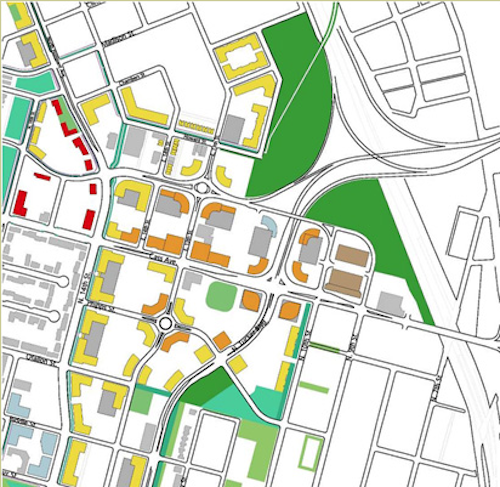
New buildings were shown up to the streets, with parking behind — the way we should be things in the center of the region. Someone may drive to work, but it makes walking to lunch, for example, feasible. Constructing new buildings back behind surface parking is typical suburbia — it has no place in the urban core of the region — not minutes from the Central Business District.
Years ago Paul McKee said he wanted to build walkable urbanism — not the drivable suburbia he was known for. Last week he presented a plan for two new buildings, one on each side of Tucker, that are highly suburban in their site planning.
The GreenLeaf Market will be located at 1408 N. 13th St., not far from the Stan Musial Veterans Memorial Bridge. Right across the street, McKee said there will be the ZOOM Store — a gas station, store and car wash.
“We expect the ZOOM Store to open by Thanksgiving and the other market to open by March 1,” McKee said. (St. Louis Public Radio)
The worst-case scenario has come true — McKee is planning to build suburbia within minutes of the central business district. Not the pedestrian & transit-friendly vision he initially communicated.
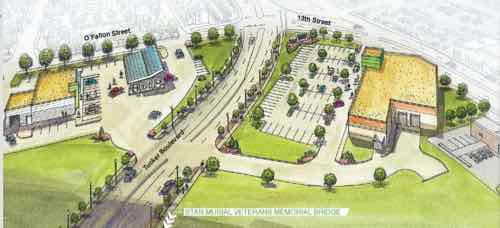
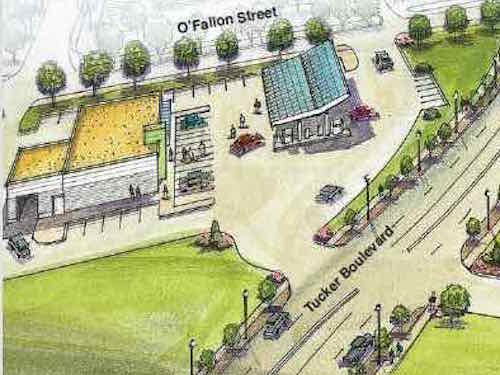
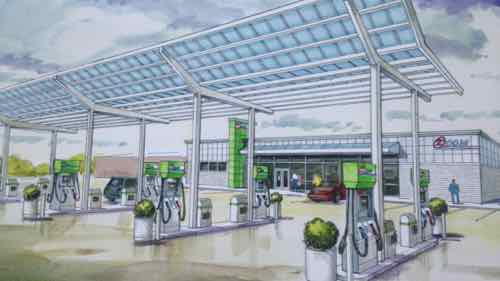
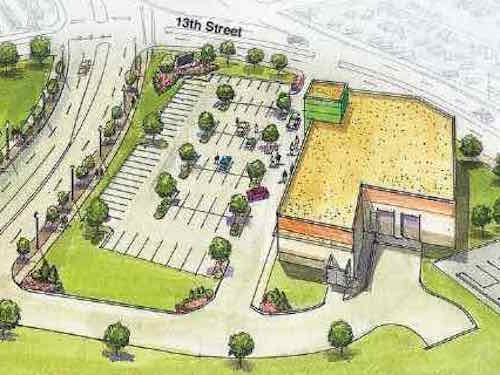
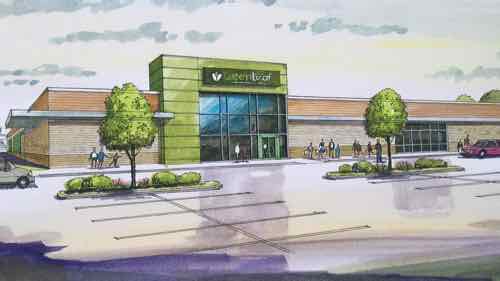
Both would be easy to have a pedestrian access route to a side street — ZOOM to O’Fallon and GreenLeaf to 13th. Technically achieving the bare minimum required by the Americans with Disabilities Act (ADA) is still a long way from being pedestrian-friendly.
I’ve defended McKee’s efforts to build new urbanism in areas such as the 22nd St Parkway interchange, Pruitt-Igoe, and Tucker & Cass. That was based on him indicating his intention to do something positively urban, not ordinary suburban. These first buildings will set the pattern for this area.
I’ve been visiting & photographing this area since work on the new Tucker began. Here are some images from 2012:
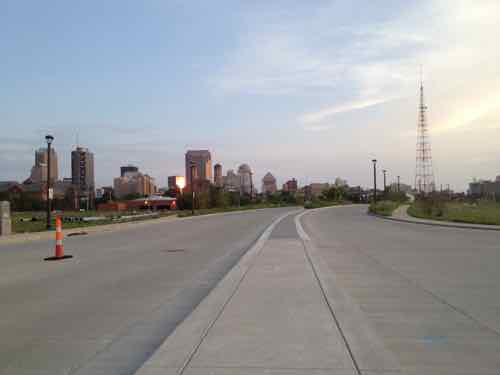
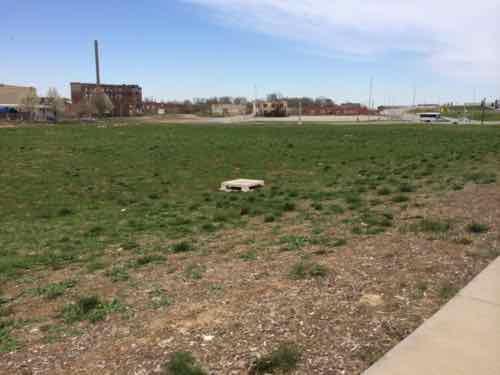
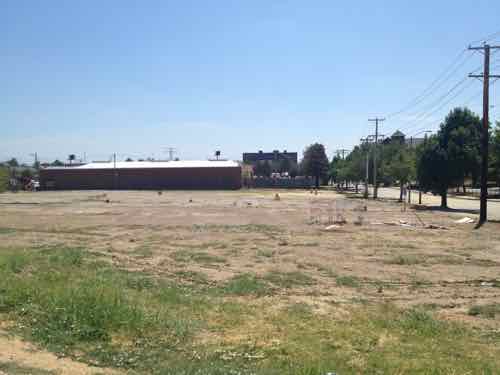
Last month I went back again:
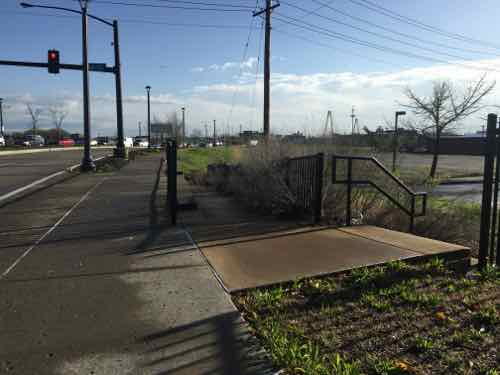
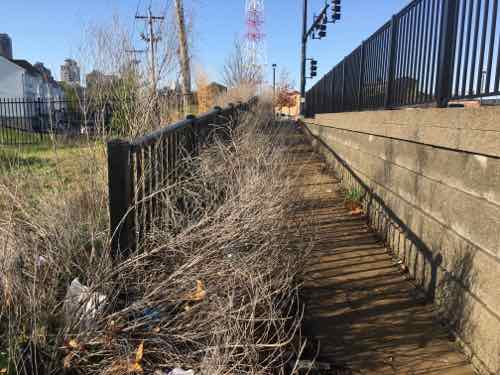
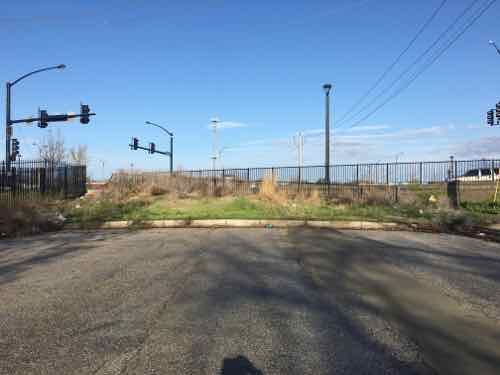
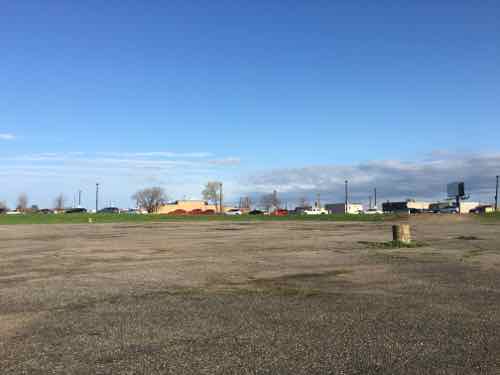
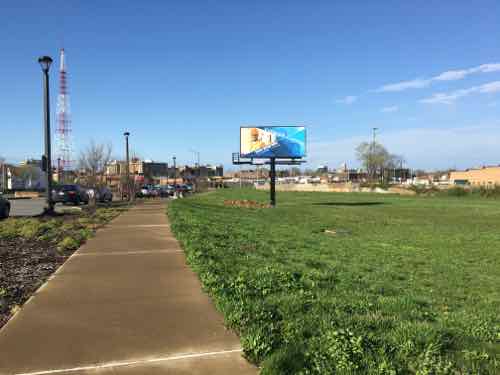
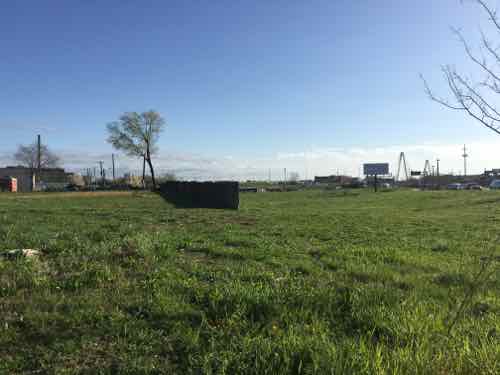
How we begin building on these large swaths of land matter, we need to ensure people can walk from building to building in the most direct manner possible — not some circuitous route or through surface parking lots. I’ve already contacted Good Natured Family Farms to tell them I welcome a grocery store — but not in a suburban form.
— Steve Patterson
Same answer as yesterday – after decades of decline, saying “no”, to pretty much anything “suburban”, is NOT a way to turn the tide in the city, especially on the north side. You may not agree, but something IS etter than nothing. And because this is/will be low-quality, “suburban crap”, tearing it down and replacing it in 20, 30 or 40 years won’t cause anyone too much angst or financial hardship, once the ECONOMIC argument for urban densities returns. (Just because it was once denser, and you believe that it must return to, or exceed, previous densities, ain’t gonna make it happen – money talks, way more than design guidelines or government-mandated density requirements!)
For decades people have been saying the city should build whatever anyone wants — it hasn’t worked. Failed suburban projects from the past are all over the city — especially old gas stations. I’ve personally seen this for over a quarter century. Here’s an idea — try something different! Actually build real places where people would enjoy walking!
My objection isn’t to the uses, my problem is where they plan to locate the buildings on the sites. These could easily be designed to welcome drivers AND pedestrians. A win-win.
But this is a poor black area, so they get crappy suburban design. Even though the poor need pedestrian friendly spaces More than do hipsters and the rich white folks in CWE and Lafayette Square.
The southside got crappy urban design in that failed KMart plaza on Manchester.
And what a disaster that turned out to be….
Pretty much all of St. Charles County is “crappy suburban design”, and most of it is neither “poor” nor “black”!
Pedestrians are catered to when they’re the majority of customers. Motorists are catered to when they’re the majority of customers. Amish driving horses and buggies are catered to when they’re a significant part of the customer base: https://farm2.staticflickr.com/1227/1259625440_aa3bd68044_o.jpg
http://www.impactlab.net/wp-content/uploads/2009/10/Horse-Parking-374.jpg
That’s the kind of simplistic, discredited thinking that gave us the wretched suburbs and the anti-pedestrian nightmare we now have. If that’s what you want, go live in the suburbs. We are desperately trying to hold on to the last bit of walkable, urban St. Louis that remains.
I don’t disagree with the goals – I’d love to see more density and more mixed-use happening (as it is in Seattle, Austin, Denver and Brooklyn). But this is far more of an economic challenge than a planning failure. Until our city sees massive inward migration, at least doubling our current population of 318,000, there really are few, valid, economic, reasons to build dense, “good”, urban projects (which, by definition cost more to build than “crappy suburban architecture”), in most St. Louis neighborhoods. See http://denverinfill.com/blog/ . This isn’t happening, here, because longtime residents said “we want”, this is happening because tens of thousands of new residents are saying “where do I sign on the dotted line?”
I laughed out loud when I clicked on the pics. How long did it take you to find them? They helped to make a miserable day “un-miserable”! Thanks.
not long – google hand buggy parking
I agree, try something different. Where we disagree is in how to make it happen. It would be far better to figure out why density is increasing in the CWE / Cortex area (or Austin or Nashville or Denver), and replicate it here, and elsewhere, instead of saying that we need some planning document, backed up by a city planner, wielding police / veto powers, to “make” people do something they see no economic reason in doing!
We get it. You are a libertarian. Good for you. Go vote for Rand Paul.
gmichaud is the libertarian of the group!
. . . and you can play the authoritarian fascist!
The point is it doesn’t have to be suburban. It could be urban. Suburban is quick, cheap and easy and ugly. City residents deserve better.
This has absolutely nothing to do with either race or economic status, it has to do with supply (high) and demand (low). Surface parking is a poor use of urban land, but it is a use, with a value that can be assigned to it, just like a church or an office building. Property owners, be they rural, suburban or urban, make choices about what they value as the highest and best use of THEIR land. If an owner or a developer can sell or rent a dense, urban form (and make a profit) THEY WILL!!!!!! If they can’t, they might put in a mini-mart, a self-storage facility, a surface parking lot or an apartment building. Consumers consume. If they ain’t buyin’ what you’re sellin’, guess what? You ain’t gonna be in business very long! McKee isn’t doing a gas station and a mini-mart because he hates urban architecture, he’s doing it because he’s pretty sure that he’ll make some money doing so!
And Smart Growth advocates believe residents of a city should have a say in how their city looks, how it is designed, whether for people first or for cars first. Whether it is ugly or beautiful. We have to live here. We are oppressed by ugly buildings. This is taken for granted in Europe. All you think about is money. There is also quality of life to consider. I know, libertarians dont give a rats ass about quality of life. Only about moolah moolah moolah.
https://www.google.com/url?sa=t&rct=j&q=&esrc=s&source=web&cd=1&cad=rja&uact=8&ved=0ahUKEwiZyMWPvvjLAhUF6SYKHaxIAdkQFgi3ATAA&url=https%3A%2F%2Fen.wikipedia.org%2Fwiki%2FDancing_House&v6u=https%3A%2F%2Fs-v6exp1-v4.metric.gstatic.com%2Fgen_204%3Fip%3D99.194.194.134%26ts%3D1459893217173752%26auth%3Dlrcwa7sqg7m5q6blq7mlihroy4s753xj%26rndm%3D0.1919670675609233&v6s=2&v6t=55416&usg=AFQjCNGRUG8hIS5S7M0t-_-9AHBYb4bHHA&sig2=LxcNpeZ3AkhTw07fAVtLUg&bvm=bv.118443451,d.eWE
Ugly? You can’t possibly be talking about the degree of ugliness that my former neighbor is used to designing. I’m sure the other side of the building looks much better.
If the link doesn’t open, type in your browser: Dancing House, Frank Gehry.
And for a different perspective, read “Learning from Las Vegas”: https://mitpress.mit.edu/books/learning-las-vegas
One more example of surface parking being replaced by new urban density: http://denverinfill.com/blog/2016/04/new-lower-downtown-project-1510-market.html
And here is a classic example of supply (low) and demand (high) at work – Denver, opening day for the Colorado Rockies, $80 a spot, in a surface parking lot!: http://www.imfromdenver.com/outrages-parking-prices-for-rockies-opening-day/
I’ve never studied much urban planning, but I suppose it’s argued that by placing parking between the street and the building provides for a safer parking environment, with more visual exposure to the main thoroughfare. More eyes on parking! But why not rotate the building 90 degrees, to the end that its orientation runs perpendicular to and close to the sidewalk, thus providing direct access from the sidewalk into the building, and then place the parking lot not in the rear of the building but rather on the other side of the building. Essentially this would entail building two main facades on the building,(one could be active; the other can be merely decorative) but it would provide direct access from the sidewalk and a parking area that is highly visible from both directions (moreso from one direction vs the other).
Parking in front evolved over the last 50-60 years, at first just a little but it grew. This pushed buildings back from the sidewalk, resulting in fewer pedestrians & transit users. Those who couldn’t afford a car have been forced to 1) struggle to have a car or 2) walk in environments not designed for walking.
There are many examples of retail stores with parking on the side or behinds — and yes two entrances is an option. It takes a little effort, but the long-term payoff is huge.
Pushing the buildings back had little impact in the decline of pedestrians and transit users. The increasing availability and affordability of the private automobile, especially following WW II had a much bigger impact (on people choosing a quick, direct, affordable drive, over a longer, more arduous trip either walking or using public transit). The changes in urban and suburban forms reflect the changes in mobility, not the other way around.
As for “two entrances [are] an option”, yes they are, IF you can afford to hire enough staff to keep an eye on both of them. Retail “shrinkage” is a huge problem, one that most retailers don’t want to publicize, and having a single public access point does wonders to minimize both theft and staffing costs.
I thought about the double-entrance/staffing dilemma not long after I posted. Then I thought of a solution which would include a single entrance located in the center of the building elevation that runs parallel to the street. The entrance would be accessible off a concrete walk that extends to both the parking lot and to the city sidewalk. How’s that for a structural “ainganeer” playing “arsheteck”?
One example of which you speak: https://www.google.com/maps/@38.5725413,-90.2824683,3a,75y,350.56h,76.87t/data=!3m7!1e1!3m5!1sM7CJ8ng7CaLwjUR_QoMIhA!2e0!6s%2F%2Fgeo3.ggpht.com%2Fcbk%3Fpanoid%3DM7CJ8ng7CaLwjUR_QoMIhA%26output%3Dthumbnail%26cb_client%3Dmaps_sv.tactile.gps%26thumb%3D2%26w%3D203%26h%3D100%26yaw%3D257.4234%26pitch%3D0!7i13312!8i6656
You know as well as I that McKee will never build that grocery store. (Why else is he saying the gas station first, the grocery store a year or so later….) He is only interested in the gas station and used the promise of a store to sweeten the deal. He cannot be trusted. What’s more, the convenience store market is oversaturated. It will be a crime if he gets public money for this.
THIS.
By my reckoning, Northside can’t be successful if it maintains or reinforces the physical/psychological divide between Near North and Downtown/West. For the edges, this means a more natural tapering down of the business/residential mix of downtown, with the build-up of QoL amenities/business growth/infrastructure improvements the near north needs.
The grocery is great, don’t get me wrong, but it should have a residential component to encourage growth and investment northward.I’m not saying this wedge-shaped lot needs to be St. Louis’ answer to the Flat Iron Building (though that would be amazing!), but a modest, modern 4-6 stories above/around would do the trick. A gas station could still be tucked in at its rear, still visible and accessible to Bridge Corridor travelers, but not as physically overpowering.
St. Louis’ neighborhoods (and the City as a whole) are held back by the fact they’re so disconnected from one another — the “space between” is uninviting and inhospitable. Downtown is the biggest culprit, with a poor pedestrian AND motorist experience northward, southward and westward. This parcel — which may be the most important “stitch” out of the whole area — could change that, but emphatically does not, as planned. And it sets a poor precedent for the project moving forward.
Overall, I feel the City has a responsibility to dictate design and development patterns that address a larger view of the project — a view that not only focuses on stabilizing the north side for its remaining businesses and residents, but encourages new business growth and new residential interest. McKee will be asking for more TIF to do this project, and it’s the City’s right (and duty?) to insist he come up with something better.
There is not going to be a grocery store. Trust me.
“Millennials are coming back to the city,” McKee asserted. “And among the top 10 things they want — the No. 1 thing is a gas station that serves good food…”
…according to some poll results that I made up ’cause I wanna build a gas station!
http://stlouis.cbslocal.com/2016/03/23/mckee-promises-new-grocery-store-gas-station-on-north-side/
There’s a gas station in Foley, AL that serves some of the best fried chicken I’ve ever eaten. And with the purchase of one whole chicken, you get three giant dill pickles–free! Maybe McKee’s on to something here! (The Ghost doubts the grocery store will be built. I do too. I have the same feeling about the gas station.)
“There’s a gas station in Foley, AL that serves some of the best fried chicken I’ve ever eaten.”
They must be inundated with millennials!
This illustrates the complete lack of leadership by the City of St Louis. How can this be after years of McKee doing nothing?
There are two real choices here: one is to design or redesign the city to be auto orientated only, the other is to redesign north city to be pedestrian, bicycle and transit friendly while coexisting with the automobile.
Half of St. Charles County does not have sidewalks, even the County Library on Hwy K has no way in except as an auto. There is a sidewalk in front of the property, but it connects to absolutely nothing, in any direction. It is not a place for kids to bike or walk to. In other words the epitome of an auto centric environment.
In contrast pedestrian traffic means the possibility of bicycles, transit, of public space geared to humans and if done right, attractive environments for walking.
The biggest failure is the absolute silence about the potential for using transit to encourage economic development. There are many things a developer cannot necessarily initiate. Certainly broader planning goals for the good of the city is one of them.
City government should have comprehensive understandings and public discussions about these issues. They have had years to do so, but have not acted as McKee has twiddled his thumbs, collecting millions.
As a reward the public gets surprised by a piecemeal, auto centric approach totally divorced from what St. Louis needs to be successful in the future. And once again the public has no say in that future.
How is the exclusionary approach of St Charles appropriate for the City of St Louis? Inclusion of pedestrian, bicycles and transit in daily life is important for an urban area like St. Louis. Where are the city officials to insure a debate? When it comes to inclusion St. Louis Democrats are a big failure.
Steve you say it is a highly inappropriate plan, I think you are being too nice. The public has no voice despite having chipped in some 40 million bucks to be invested in McKee and now there are TIFs on top of that subsidy. At this point the whole thing is almost a criminal enterprise, except it is legal since they make the laws too.
There is little in St. Louis’ Euclidian Zoning that precludes the dense, urban, structures that many people claim to want or say are “needed”, yet those with the resources to make this type of construction continue to choose not to do it! Instead of trying to dream up new rules to try and make this happen, how about figuring out why people are choosing NOT to maximize what they are currently allowed to do?!
I visited the proposed site of the Greenleaf Market and ZOOM gas station at the N. 13th and Tucker intersection today (August 2, 2016), and not a thing has been done, although Mr. McKee indicated in March 2016 that work could begin in July. He’s gotten the USDA to guarantee 70% of the loan for the grocery and the Board of Alderman to extend $2.8 million in tax credits for it and the gas station, but STILL has not broken ground for what should be two of the easiest parts of his grand scheme to rejuvenate the NorthSide. Would he please do SOMETHING, ANYTHING to show that NorthSide Regeneration is nothing but a pipe dream?
I visited the proposed site of the Greenleaf Market and ZOOM gas station at the N. 13th and Tucker intersection today (August 2, 2016) and I think no one will have to worry about whether they are pedestrian-friendly. Despite Mr. McKee’s announcement in March 2016 that work could begin in July, not a thing has been done! This even though he has gotten what he wanted – the USDA to guarantee 70% of the loan for the grocery and the Board of Alderman to extend $2.8 million in tax relief for both it and the gas station. I think this is just another example of NorthSide Regeneration’s failure to follow through on their promises.
I visited the proposed site of the Greenleaf Market and ZOOM gas station at the N. 13th and Tucker intersection today (August 2, 2016) and I think no one will have to worry about whether they are pedestrian-friendly. Despite Mr. McKee’s announcement in March 2016 that work could begin in July, not a thing has been done! This even though he has gotten what he wanted – the USDA to guarantee 70% of the loan for the grocery and the Board of Alderman to extend $2.8 million in tax relief for both it and the gas station. I think this is just another example of NorthSide Regeneration’s failure to follow through on their promises.